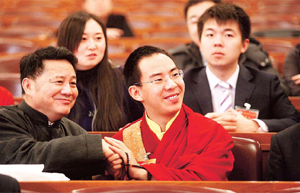Full Text: Report on central, local budgets
(Xinhua)
Updated: 2010-03-16 16:23
We implemented a stronger employment policy. Spending on employment work was 39.091 billion yuan (adding spending on employment work listed in other items to this figure, total spending reached 42.621 billion yuan), an increase of 13.883 billion yuan or 55.1%. We substituted work for relief through government financing of public works projects. We helped enterprises with financial difficulties to keep their employment levels stable by allowing them to postpone their payments of contributions to five types of social security for a set period of time, including contributions to basic old-age pensions, and temporarily reduced their contributions to four types of insurance, including unemployment insurance. We continued to implement tax support policies for laid-off workers to become self-employed and for enterprises to provide employment opportunities to laid-off workers. We instituted the policies of reimbursing tuition and granting state education assistance loans to promote the employment of college graduates. We introduced preferential policies for key enterprises and research projects to absorb college graduates in order to keep their employment stable. We improved the employment assistance system for college graduates who have difficulty finding jobs. We launched special vocational training programs for the urban unemployed and 21 million rural migrant workers who had returned to their villages.
5) Expenditures on low-income housing amounted to 55.056 billion yuan, 111.7% of the budgeted figure and an increase of 36.866 billion yuan or 202.7%. Excess spending was mainly due to greater financial support for the construction of low-income housing. This amount consisted of 2.643 billion yuan of central government spending and 52.413 billion yuan of transfer payments to local governments. A total of 33 billion yuan was used to raise the level of investment subsidies to local governments for building low-rent housing, and intensify the construction of low-rent housing and other low-income housing to solve the housing problems of 2.6 million low-income urban families. We spent 10 billion yuan on accelerating the renovation of run-down areas in state-owned forest regions and land reclamation zones and around coalmines, and helping to solve the housing problems of 1.3 million households. We spent 2.3 billion yuan to carry forward the project to build permanent housing for nomads in ethnic minority areas, and provided 92,000 families with permanent homes. We provided 4 billion yuan in subsidies for expanding pilot projects to renovate dilapidated rural houses to more areas, which benefited 800,000 households.
6) Expenditures on culture, sports, and mass media totaled 32.073 billion yuan, 114.6% of the budgeted figure and an increase of 6.792 billion yuan or 26.9%. Excess spending was largely on public culture in rural areas. This total consisted of 15.475 billion yuan of central government spending and 16.598 billion yuan of transfer payments to local governments. We vigorously developed non-profit cultural programs and supported free admission to museums, memorial halls, and national patriotic education demonstration centers. The central government granted subsidies to 1,444 museums and memorial halls for this purpose. Implementation of key cultural projects that benefit the people, such as rural reading rooms and the extension of radio and television coverage to all villages, progressed smoothly. We strengthened the protection of major cultural and historical sites, key cultural relics, and our intangible cultural heritage.
7) Expenditures on the reserves of grain, edible oil, and other materials totaled 174.662 billion yuan, 98.1% of the budgeted figure and an increase of 64.789 billion yuan or 59%. This total consisted of 80.543 billion yuan of central government spending and 94.119 billion yuan of transfer payments to local governments. We provided 15.1 billion yuan in ongoing direct subsidies to grain growers. A total of 72.119 billion yuan was used to strengthen the reserves system to gradually increase the grain and edible oil reserves of the central government and its temporary grain and edible oil reserves, and also to increase the reserves of important materials including nonferrous metals and special steel products by 2.49 million tons. We supported significant increases in minimum grain purchase prices, and spent 9.9 billion yuan to subsidize related interest and expenses. We disbursed 32 billion yuan in subsidies implementing the policy to encourage rural residents to purchase home appliances and motor vehicles including motorbikes and consumers to trade-in old home appliances and motor vehicles for new ones. We used 7.6 billion yuan to promote the development of the logistics services industry and improve the rural logistics system.
8) Expenditures on science and technology came to 151.202 billion yuan, 103.5% of the budgeted figure and an increase of 34.879 billion yuan or 30%. This figure consisted of 143.385 billion yuan of central government spending and 7.817 billion yuan of transfer payments to local governments. We spent 94.676 billion yuan on intensifying basic and applied research, and 32.8 billion yuan on accelerating the development of major science and technology projects. We disbursed 20 billion yuan in technological innovation funds to implement the plan for restructuring and invigorating ten key industries, support 4,441 technological upgrading projects, and promote technological upgrading and independent innovation in enterprises. We promoted the development of regional scientific and technological innovation systems and the intimate integration of enterprises, universities, research institutes, and end-users.
9) Expenditures on environmental protection came to 115.18 billion yuan, 93.1% of the budgeted figure and an increase of 11.15 billion yuan or 10.7%. Spending was less than the budgeted figure mainly because the subsidies actually paid out for returning farmland to forests were less than forecast. This sum consisted of 3.79 billion yuan of central government spending and 111.39 billion yuan of transfer payments to local governments. A total of 56.747 billion yuan was spent on encouraging energy conservation and emissions reductions, supporting 1,318 key energy-saving projects and 132 key recycling and resource conservation projects, and helping 1,116 enterprises to retrofit energy-conserving technology. We constantly improved our environmental monitoring capabilities, and helped standardize 497 environmental monitoring stations and 617 environmental oversight and law enforcement bodies. We carried out 1,049 projects in the course of implementing major programs for reducing pollution, including the prevention and control of water pollution in key watersheds. We supported the construction of 13,800 kilometers of pipelines for urban sewage treatment systems. We implemented a project to promote products that conserve energy and benefit the people, and put more than 5 million energy-saving air-conditioners and 150 million energy-efficient light bulbs into use. We increased the application of high-efficiency, energy-conserving products and motor vehicles powered by new energy sources. We spent 7.679 billion yuan on accelerating the development of renewable energy. We pushed forward the implementation of the Golden Sun Project and developed the photovoltaic industry. We promoted the development of biomass energy and wind power. We used 46.636 billion yuan to protect virgin forests, consolidate progress already made in returning farmland to forests, and conserve grasslands. We improved all aspects of the environment in 1,465 villages in order to make them ecological conservation models.


